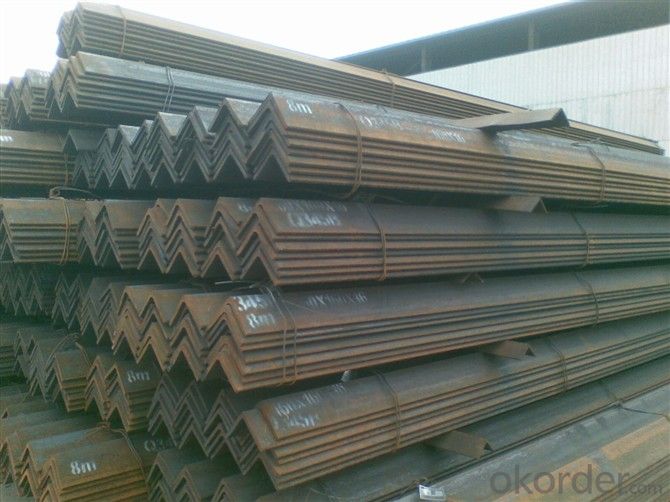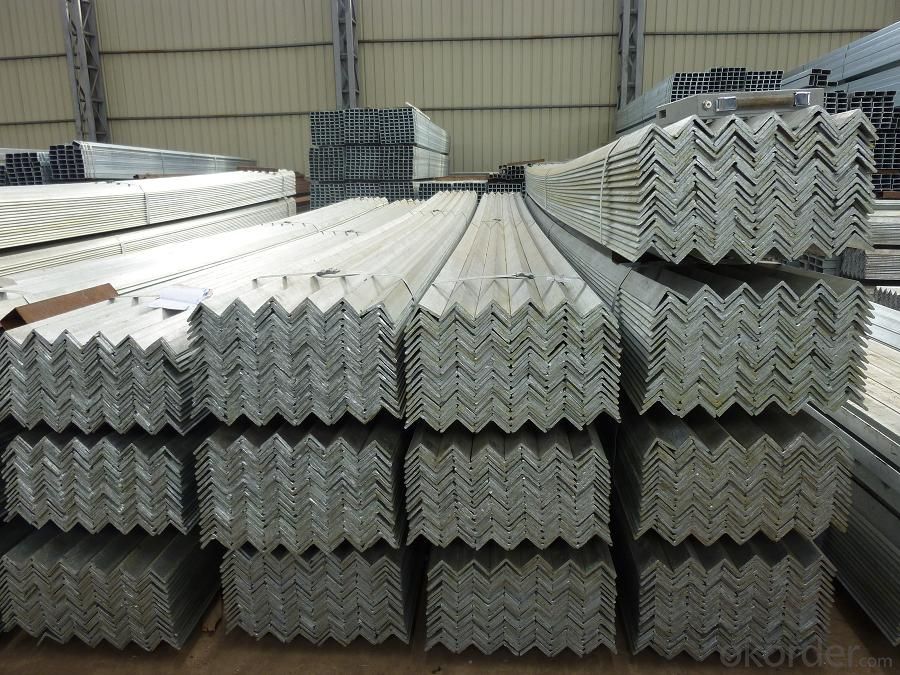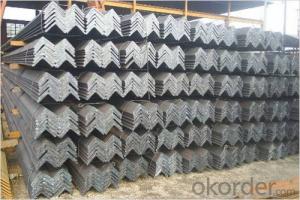Steel Equal Angle Hot Rolled Steel Profile Carbon Equal Angle
- Loading Port:
- Tianjin
- Payment Terms:
- TT or LC
- Min Order Qty:
- 28 m.t.
- Supply Capability:
- 35000 m.t./month
OKorder Service Pledge
OKorder Financial Service
You Might Also Like
Product Description of Steel Equal Angle Hot Rolled Steel Profile Carbon Equal Angle:
OKorder is offeringHot Rolled Steel Equal Angle Unequal Angle at great prices with worldwide shipping. Our supplier is a world-class manufacturer of steel, with our products utilized the world over. OKorder annually supplies products to European, North American and Asian markets. We provide quotations within 24 hours of receiving an inquiry and guarantee competitive prices.
Product Applications of Steel Equal Angle Hot Rolled Steel Profile Carbon Equal Angle:
Hot Rolled Steel Equal Angle Unequal Angle are ideal for structural applications and are widely used in the construction of buildings and bridges, and the manufacturing, petrochemical, and transportation industries.
Product Advantages of Steel Equal Angle Hot Rolled Steel Profile Carbon Equal Angle:
OKorder's Hot Rolled Steel Equal Angle Unequal Angle are durable, strong, and resist corrosion.
Main Product Features of Steel Equal Angle Hot Rolled Steel Profile Carbon Equal Angle:
· Premium quality
· Prompt delivery & seaworthy packing (30 days after receiving deposit)
· Corrosion resistance
· Can be recycled and reused
· Mill test certification
· Professional Service
· Competitive pricing
Product Specifications of Steel Equal Angle Hot Rolled Steel Profile Carbon Equal Angle:
Specifications of Angle Steel
1. Invoicing on theoretical weight or actual weight as customer request
2. Length: 6m, 9m, 12m as following table
3. Sizes
Sizes: 25mm-250mm | ||
a*t | ||
25*2.5-4.0 | 70*6.0-9.0 | 130*9.0-15 |
30*2.5-6.6 | 75*6.0-9.0 | 140*10-14 |
36*3.0-5.0 | 80*5.0-10 | 150*10-20 |
38*2.3-6.0 | 90*7.0-10 | 160*10-16 |
40*3.0-5.0 | 100*6.0-12 | 175*12-15 |
45*4.0-6.0 | 110*8.0-10 | 180*12-18 |
50*4.0-6.0 | 120*6.0-15 | 200*14-25 |
60*4.0-8.0 | 125*8.0-14 | 250*25 |
5. Payment terms:
1).100% irrevocable L/C at sight.
2).30% T/T prepaid and the balance against the copy of B/L.
3).30% T/T prepaid and the balance against L/C
6.Material details:
Alloy No | Grade | Element (%) | |||||
C | Mn | S | P | Si | |||
|
|
|
|
|
|
| |
Q235 | B | 0.12—0.20 | 0.3—0.7 | ≤0.045 | ≤0.045 | ≤0.3 | |
|
|
|
|
|
|
| |
Alloy No | Grade | Yielding strength point( Mpa) | |||||
Thickness (mm) | |||||||
≤16 | >16--40 | >40--60 | >60--100 | ||||
≥ | |||||||
|
|
|
|
|
| ||
Q235 | B | 235 | 225 | 215 | 205 | ||
Alloy No | Grade | Tensile strength (Mpa) | Elongation after fracture (%) | ||||
Thickness (mm) | |||||||
| ≤16 | >16--40 | >40--60 | >60--100 | |||
≥ | |||||||
|
|
|
|
|
|
| |
Q235 | B | 375--500 | 26 | 25 | 24 | 23 | |
Usage & Applications of Steel Equal Angle Hot Rolled Steel Profile Carbon Equal Angle
According to the needs of different structures, Angle can compose to different force support component, and also can be the connections between components. It is widely used in various building structures and engineering structures such as roof beams, bridges, transmission towers, hoisting machinery and transport machinery, ships, industrial furnaces, reaction tower, container frame and warehouse etc.
Packaging & Delivery of Steel Equal Angle Hot Rolled Steel Profile Carbon Equal Angle
1. Packing: it is nude packed in bundles by steel wire rod
2. Bundle weight: not more than 3.5MT for bulk vessel; less than 3 MT for container load
3. Marks:
Color marking: There will be color marking on both end of the bundle for the cargo delivered by bulk vessel. That makes it easily to distinguish at the destination port.
Tag mark: there will be tag mark tied up on the bundles. The information usually including supplier logo and name, product name, made in China, shipping marks and other information request by the customer.
If loading by container the marking is not needed, but we will prepare it as customer request.
Production flow of Angle Steel
Material prepare (billet) —heat up—rough rolling—precision rolling—cooling—packing—storage and transportation



- Q:What are the common applications of steel angles in the automotive industry?
- Steel angles are commonly used in the automotive industry for various applications such as reinforcing structural components, supporting body panels, creating brackets and mounts, and enhancing overall vehicle safety and stability.
- Q:How do you calculate the stability of a steel angle column?
- Determining the stability of a steel angle column involves considering several crucial factors. The first step is to calculate the slenderness ratio of the column, which is the ratio between its effective length and its least radius of gyration. This can be done using the following formula: Slenderness ratio = (Effective length of column) / (Least radius of gyration) To find the least radius of gyration, the dimensions of the angle section must be used. For a steel angle, an approximation can be made by taking the average of the two legs of the angle section and dividing it by the square root of 3. Once the slenderness ratio is determined, it is necessary to assess whether the column is classified as long or short. If the slenderness ratio is below the critical value, typically around 50 for an angle column, it is considered short, and its stability primarily depends on its strength. In such cases, the column can be designed based on its ability to resist axial compression and flexural buckling. However, if the slenderness ratio surpasses the critical value, the column is classified as long, and its stability depends on its capacity to resist lateral-torsional buckling. In these instances, additional calculations and considerations are required to ensure the column remains stable. For long angle columns, the critical load at which lateral-torsional buckling may occur can be determined using various formulas and methods, such as the Euler formula, the Perry-Robertson formula, or finite element analysis. These calculations take into account various parameters, including the moment of inertia, modulus of elasticity, and length of the column. It is important to acknowledge that stability calculations for steel angle columns can be intricate and necessitate expertise in structural engineering. It is strongly advised to consult with a qualified professional or refer to relevant design codes and standards, such as the American Institute of Steel Construction (AISC) Manual, for accurate and reliable calculations.
- Q:What is the maximum allowable torsional stress for a steel angle?
- The maximum allowable torsional stress for a steel angle depends on several factors, including the specific grade of steel, the dimensions and shape of the angle, and the intended application. Steel angles are commonly used in structural applications, such as supporting beams and frames, and they are designed to withstand various types of stresses, including torsional stress. To determine the maximum allowable torsional stress for a steel angle, engineers typically refer to industry standards and codes, such as the American Institute of Steel Construction (AISC) Manual or the European standard EN 10056. These standards provide guidelines and formulas for calculating the maximum allowable torsional stress based on the properties of the steel angle, such as the cross-sectional area, moment of inertia, and modulus of elasticity. It is important to note that the maximum allowable torsional stress is usually specified as a percentage of the yield strength or ultimate tensile strength of the steel. This ensures that the angle can safely withstand torsional loads without undergoing permanent deformation or failure. In practical applications, engineers and designers must carefully analyze the specific requirements and loading conditions to determine the appropriate maximum allowable torsional stress for a steel angle. They consider factors such as the magnitude and direction of the applied torque, the angle's orientation, and any additional loads or constraints that may be present. Ultimately, the maximum allowable torsional stress for a steel angle is a critical parameter in ensuring the structural integrity and safety of a given design. Proper consideration of the steel's properties, industry standards, and specific application requirements is essential for making accurate calculations and selecting an appropriate steel angle that can effectively resist torsional stress.
- Q:What are the different types of connections used with steel angles?
- There are several different types of connections used with steel angles, depending on the specific needs and requirements of the structure. Some of the most common types of connections include: 1. Welded Connection: This is one of the most popular types of connections used with steel angles. It involves welding the angle to another steel member, such as a beam or column, using various welding techniques. Welded connections provide excellent strength and stability. 2. Bolted Connection: Bolted connections involve using bolts and nuts to secure the steel angle to another component. This type of connection allows for easy disassembly and offers flexibility in adjusting or replacing components. Bolted connections are often used when there is a need for future modifications or repairs. 3. Riveted Connection: Riveted connections were widely used in the past but are less common today. They involve using rivets to connect the steel angle to other components. Riveted connections provide high strength and durability, but they require specialized skills and equipment for installation. 4. Gusset Plate Connection: In some cases, a gusset plate is used to connect steel angles. A gusset plate is a flat plate that is typically bolted or welded to the angle and the other component, providing additional strength and stability. 5. Moment Connection: A moment connection is a specialized type of connection used to transfer bending moments between steel angles and other components, such as beams or columns. Moment connections are designed to handle significant loads and provide enhanced structural integrity. Overall, the choice of connection type depends on factors such as load requirements, structural design, ease of installation, and potential for future modifications. Each type of connection has its own advantages and limitations, and the appropriate connection type is determined by a structural engineer based on the specific project requirements.
- Q:Are steel angles resistant to impact?
- Steel angles are known for their exceptional strength and durability, which makes them highly resistant to impact. Due to their structural design and composition, steel angles can withstand significant forces without deforming or breaking. This resistance to impact is attributed to the hardness and toughness of steel, allowing it to absorb and dissipate energy from external forces. Additionally, steel angles can be further reinforced or coated to enhance their impact resistance, making them a popular choice in various applications such as construction, automotive manufacturing, and industrial machinery. However, it is essential to note that the impact resistance of steel angles can vary depending on factors such as the specific grade of steel used, the angle's dimensions, and the manner in which it is installed or utilized.
- Q:Can steel angles be used in conveyor systems or material handling equipment?
- Conveyor systems and material handling equipment can indeed incorporate steel angles. These steel angles, also referred to as angle iron, are frequently employed in such applications due to their versatility and structural strength. By effortlessly welding, bolting, or riveting them together, a variety of framework structures for conveyors and material handling equipment can be created. Notably, steel angles offer stability and support for heavy loads, enabling the construction of frames, supports, and guards for conveyor belts, rollers, chutes, and other vital components. Moreover, steel angles come in various sizes and thicknesses, catering to diverse application requirements. As a result, they are a highly favored option for the construction of conveyor systems and material handling equipment.
- Q:How do steel angles perform in terms of vibration resistance?
- Steel angles generally have good vibration resistance due to their rigid and stable structure. The L-shape design of steel angles helps to distribute and absorb vibrations, making them suitable for various applications where vibration resistance is important, such as in construction and engineering projects.
- Q:Can steel angles be used for conveyor supports?
- Conveyor supports can indeed utilize steel angles. These angles find frequent application in industrial settings, such as conveyor systems, where their structural integrity and durability offer exceptional strength and support. By welding or bolting steel angles together, one can effortlessly construct robust and steadfast conveyor frames. Moreover, their adaptability permits tailoring to meet precise design prerequisites. All in all, steel angles prove themselves as dependable and economical options for supporting conveyors.
- Q:How are steel angles protected against impact or collision damage?
- Various methods can be utilized to safeguard steel angles against impact or collision damage. One effective approach involves strategically positioning protective barriers or bollards around the angles to absorb the impact and prevent direct contact. The choice of materials for these barriers, such as concrete, rubber, or steel, depends on the desired level of protection. An alternative method is to directly install impact-resistant guards or shields onto the steel angles. These guards are typically constructed from materials like polyethylene, rubber, or heavy-duty plastic, which possess the ability to absorb impact and minimize damage. For added protection, reinforcement elements like steel plates or bars can be incorporated into the guards. Moreover, steel angles can be coated or painted with impact-resistant coatings or paints. These specialized coatings are designed to effectively disperse and absorb the force of an impact, thereby reducing the likelihood of damage. Additionally, they provide an extra layer of defense against corrosion, further safeguarding the angles from deterioration caused by impact. Lastly, engineering and design considerations play a crucial role in protecting steel angles against impact damage. By thoroughly evaluating the structural requirements and potential risks, engineers can make informed decisions regarding appropriate dimensions, materials, and reinforcement techniques. Factors such as load-bearing capacity, impact force distribution, and structural integrity are carefully considered to enhance the angles' resistance to collision damage. In conclusion, the protection of steel angles from impact or collision damage entails a combination of physical barriers, guards, coatings, and thoughtful engineering. These measures aim to mitigate the risk of damage, prolong the lifespan of the angles, and ensure their structural integrity in a wide range of applications.
- Q:What are the design considerations for using steel angles in architectural applications?
- Some design considerations for using steel angles in architectural applications include structural stability, load-bearing capacity, aesthetic appeal, corrosion resistance, and ease of installation. Steel angles are commonly used to provide support, reinforcement, and stability to various architectural elements such as beams, columns, and frames. The selection of the appropriate size, thickness, and grade of steel angle is crucial to ensure the structural integrity and safety of the building. Additionally, architects may consider the visual impact of steel angles, as they can be exposed or concealed depending on the design intent. The corrosion resistance properties of the steel angles should also be taken into account, especially in applications where exposure to moisture or harsh environments is expected. Lastly, the ease of installation and compatibility with other building materials should be considered to streamline the construction process.
1. Manufacturer Overview |
|
|---|---|
| Location | |
| Year Established | |
| Annual Output Value | |
| Main Markets | |
| Company Certifications | |
2. Manufacturer Certificates |
|
|---|---|
| a) Certification Name | |
| Range | |
| Reference | |
| Validity Period | |
3. Manufacturer Capability |
|
|---|---|
| a)Trade Capacity | |
| Nearest Port | |
| Export Percentage | |
| No.of Employees in Trade Department | |
| Language Spoken: | |
| b)Factory Information | |
| Factory Size: | |
| No. of Production Lines | |
| Contract Manufacturing | |
| Product Price Range | |
Send your message to us
Steel Equal Angle Hot Rolled Steel Profile Carbon Equal Angle
- Loading Port:
- Tianjin
- Payment Terms:
- TT or LC
- Min Order Qty:
- 28 m.t.
- Supply Capability:
- 35000 m.t./month
OKorder Service Pledge
OKorder Financial Service
Similar products
New products
Hot products
Related keywords



























